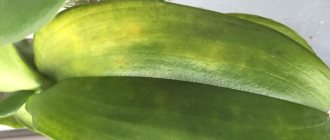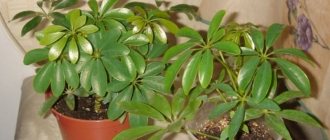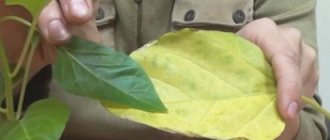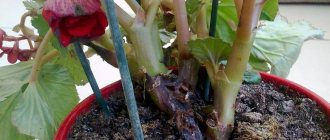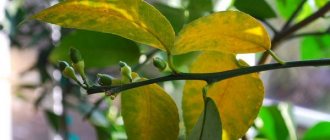The first reason is too low air humidity and insufficient watering.
Lily leaves turn yellow: photo
Lily came to us from tropical, humid forests. Therefore, during the summer heat, it may be too hot, especially if it grows in close proximity. Because of this, the leaf blades may turn yellow and even dry out. To avoid such consequences, you need to plant plants in a semi-shaded area, while maintaining a distance between the beds and holes. You also need to adjust the watering mode. The soil in which lilies grow should not dry out excessively. But it is also impossible to overfeed plants with water, this can cause rotting of the root system, which will also cause yellowing of the leaf plates.
Pests
Indoor lilies are rarely attacked by pests. But such cases do happen. The main enemies of the flower are: spider mites, aphids, mealybugs, aphids and scale insects.
The cause of each of these harmful insects is dry and hot indoor air.
Pests can be seen with the naked eye on the leaves and stems of lilies, as well as by noticeable changes in appearance: lethargy, yellowing and falling of leaf blades, slowing growth. Insecticides (actellik and karbofos) are used to control pests.
It is advisable to understand and see in time what your tropical beauty is complaining about and try to help her cope with the illness. In response to your care, she will reward you with lush flowering.
Lily leaves turn yellow if there is not enough iron elements
If the lily lacks iron, then the formation of chlorophyll will be disrupted, and it, in turn, is necessary for the normal functioning of photosynthesis. This is especially noticeable when considering young specimens, because day after day they will only become more yellow, but the veins will still remain bright green. If this happens, then you need to feed the lily. To do this you will need: 1) Two teaspoons of citric acid; 2) Eight grams of iron sulfate; 3) Three liters of clean, settled, soft water at room temperature. All this must be mixed thoroughly. It can be used both for spraying and for watering the soil in which the flower grows.
How to treat lilies with iron sulfate. inkstone
Iron sulfate or iron-II sulfate is a fungicide for protecting garden plants from fungal diseases, as well as killing mosses and lichens on trees. It is a 53% salt formed by the interaction of ferrous iron and sulfuric acid, associated with water molecules (crystal hydrate) - granules or powder of light green or gray-green color (sometimes with a brown tint), highly soluble in water.
Mechanism of action: contact. The period of protective action is 14 days. The shelf life of iron sulfate is not limited, the drug is hygroscopic, so it must be stored in a tightly closed glass or plastic container in a dry place.
Application
Iron sulfate is used in the garden to protect plants from a number of diseases:
- Alternaria
- anthracnose
- coccomycosis
- clusterosoporiosis
- gray rot
- apple and pear scab
- downy mildew
- powdery mildew
- grape oidium
Ferrous sulfate does not protect against bacterial infections. Practically not used in indoor floriculture.
Trees and shrubs can only be sprayed in spring or autumn - strictly before buds open or after leaves have fallen and branches are exposed. Iron sulfate is not used as a fertilizer and for the treatment of infections on green leaves - it causes burns to leaf tissue - the acidity of a 3-5% solution is about pH 3-5 (very acidic reaction).
Consumption rates
Typically, the following concentrations are used:
- 3% solution for stone fruits (plums, cherries, apricots, peaches, cherries, cherry plums) - 300 g of iron sulfate powder per 10 liters of water. Spray before covering bare branches or vines.
- 4-5% solution for pome fruits (apple, pear, quince, chokeberry, grapes): 400-500 g of iron sulfate powder per 10 liters of water, with a consumption rate of about 10-15 liters per 100 m2.
- 5-6% solution - to destroy mosses and lichens on trees and garden tiles, as well as basements or cellars from mold: 500-600 g of iron sulfate powder per 10 liters of water.
If you don’t have scales, measure the 2% solution by eye: half a tablespoon of iron sulfate per 1 liter of water, you will get a bright orange liquid.
Iron sulfate delays bud break (by about a week), so treatment with a 3-4% solution before the start of the growing season helps to survive the period of spring frosts. It is especially important for crops such as grapes if you apply it about a week after removing the winter shelter, exclusively on bare vines with unopened buds.
Disadvantages of iron sulfate
cannot be sprayed on leaves and young growths - iron sulfate burns them in a concentration of more than 1%; concentration up to 1% is practically ineffective for the pathogen; iron sulfate quickly oxidizes to ferric iron and loses its fungicidal properties; therefore, the period of protective action is on average only 10-14 days It is necessary to process very carefully in the spring, it is advisable to use only in the fall
The effectiveness of iron sulfate
Treatment with iron sulfate in the spring delays the opening of the buds, slows down the awakening of the bush, and this, depending on the weather, is both a plus and a minus.
If we talk about the effectiveness of iron sulfate as a fungicide, it is quite doubtful - surface spraying of branches does not completely kill the fungus, spores can persist in closed places (for example, behind the bark) and places inaccessible to treatment. Therefore, if you have valuable varieties of grapes or fruit trees, preference should be given to copper preparations: copper sulfate, Bordeaux mixture, oxychome, etc.
Although many gardeners very effectively use this scheme for treating the garden against diseases: in the spring - spraying with copper sulfate, in the fall - with iron sulfate.
Compatibility of iron sulfate
The drug is incompatible in general solutions with organophosphorus insecticides and other drugs that decompose in an alkaline environment. Mixing iron sulfate with lime is not allowed.
If there is a shortage or excess of nitrogenous elements
If a lily lacks nitrogenous elements, then its color becomes more faded, it may turn yellow, and slow down its growth and development. In this case, you need to choose a fertilizer that has an advantage of nitrogenous elements. When using such fertilizer, it is very important not to overdo it. If the crop is overfed with nitrogenous elements, then the leaf plates will become covered with brown spots, which will turn yellow over time, and the foliage itself will simply fall off. The plant bulb will also suffer. Experienced flower growers say that such a plant cannot be saved. The only thing you can do is just dig it out of the hole.
Pathological yellowing of the Amazon lily
What to do when the problem of Amazon lily shedding leaves does not fit into the framework of natural causes? If the foliage turns yellow massively and sharply, this is a signal that your green friend has serious problems, which may be caused by the following factors.
Improper watering
The most common cause of yellow leaves is excessive soil moisture. If you observe a massive loss of plant greenery, then you can suspect rotting of the bulbs. It is necessary to carefully examine the underground part of the flower for signs of rotting. Most often this is:
- A large amount of moisture on the roots, soaked bulbs.
- Softness of individual areas.
- Spots, uneven coloring.
If these signs are detected, the plant requires urgent surgical intervention. Necessary:
Using a sharp knife, carefully cut out the rotten areas down to healthy tissue. Treat the sections with activated carbon powder. Dry the bulbs well on paper. The same must be done with the soil in which the plant was located. Transplant the flower into a smaller pot in order to avoid repeated stagnation of moisture. You can water the transplanted plant no earlier than two weeks later
You can water the transplanted plant no earlier than after two weeks.
Attention! Yellowing of Amazon lily leaves may be a reaction to watering with hard water. Eucharis suffers especially severely from frequent watering in low temperatures.
However, it is also not recommended to overdry the plant. It is correct to water the flower not according to plan, but as the soil dries. If the top 3 cm of soil has not yet dried out, then watering is not necessary.
Eucharis suffers especially severely from frequent watering in conditions of low temperatures. However, it is also not recommended to overdry the plant. It is correct to water the flower not according to plan, but as the soil dries. If the top 3 cm of soil has not yet dried out, then watering is not necessary.
Failure to comply with temperature conditions
Amazon lily develops well at temperatures of 18-22 degrees. A decrease in temperature in combination with abundant watering can cause rotting of the bulbs and, as a result, yellowing and loss of green mass.
Lack or excess of nutrients
In addition to the fact that the plant needs to be fed on time, namely during the period of growth and formation of flower stalks, this should also be done correctly.
Considering that concentrated fertilizers can damage eucharis and cause yellow leaves to appear, it is better to start fertilizing with a very weak solution, gradually increasing the concentration of nutrients to those recommended in the instructions.
Important! You cannot fertilize the plant “dry”. Before fertilizing, it is necessary to moisten the soil
Dry air
It can also cause yellowing foliage. As an ambulance, you can resort to spraying the flower. However, to really solve the problem, you need to think about other ways to humidify the air.
Little light
Despite the fact that eucharis does not like direct sunlight, it still needs good lighting and reacts to its lack by the appearance of yellow leaves.
To fix the problem, you need to move the flower to the sunny side in a place protected from direct rays. You should also protect the plant from drafts.
Why do lily leaves turn yellow: bacterial rot
Many crops suffer from this disease. This disease manifests itself in that the foliage of the plant begins to turn yellow and then dies. It may appear because the plant bulb is damaged or the soil is excessively waterlogged. You can fight only with preventive measures. Before planting the bulbs, the plants need to be soaked in a manganese solution. When the first shoots appear, the plant needs to be treated with fungicidal preparations. But if you discover the disease when the plant has already entered the flowering period, then the bush will have to be destroyed, because bacterial rot cannot be treated.
How to fight?
As soon as the cause of yellowing is determined, something must be done immediately, otherwise the plant may well die. Treatment for lilies will vary.
The first thing to do is to review the rules of care, especially watering. This crop is watered often, but not much; sprinkling is also very important, which helps wash away dust and small parasites from the foliage. As for fertilizers, they are applied in very measured doses. For example, plants are fed with nitrogen only during the period of active growth. Before flowering, fertilizing is stopped, otherwise no buds will appear, all energy will be spent on gaining green mass. After flowering, you can feed with complex fertilizers for lilies, as well as potassium.
When the cause lies in an illness, it is important to correctly calculate the illness. Unfortunately, most diseases cannot be treated, and the owners of the site simply uproot the lily, take it outside the garden bed and burn it. For example, one such disease is blue mold. All diseased flowers must be destroyed, otherwise the fungus will quickly spread to others.
The only preventive measure is soaking the seeds in a Fundazol solution.
Late blight in the initial stages can be successfully treated with the use of strong fungicides, but if the plant becomes sick during flowering, the buds and leaves affected by the fungus are collected and burned away from the beds. Rust is removed in the same way, but instead of fungicides, 1% Bordeaux mixture is used here, which is sprayed on healthy plants.
Fusarium is not treated, since it is detected only in the final, most advanced stage. Sick specimens are dug up; the only preventive measure is soaking in Fundazol. As for gray rot, it can be treated quite successfully with fungicides.
A good preventative measure would be to treat the roots with Fitosporin. It is done at the very beginning of spring, when lilies quickly grow.
To get rid of nematodes, experts recommend treating the soil from time to time. In addition, regular weed removal and mulching will be a good help in solving the problem. In the most severe cases, insecticides will help. They will also be a solution to problems with other pests. Traditional methods of control include sticky traps, soap or garlic solution, and manual collection of insects.
Lily leaves turn yellow: the reason is rust
If yellow, bright orange, or brown spots appear on your lily, then you need to take a very close look at the presence of bright orange fungal spores. Outwardly, they resemble small, fluffy pillows. If these spots have a convex shape, this means that the plant is sick with rust. In this case, you must immediately remove all infected parts of the crop. And the plant itself needs to be treated with one percent Bordeaux mixture. Replanting in a place where infected plants grew is only possible after at least three years.
Methods of treatment and prevention of diseases
Prevention should be emphasized as the first step in the fight against daylily diseases. After all, while fungal diseases and pests can still be successfully combated, it is practically useless in relation to viral infections.
Foundationazol for prevention
Prevention
Preventive measures are recommended:
- in the fall - when storing seed, it is advisable to sort it, leaving only healthy specimens;
- in the spring, before planting the bulbs in open ground, it is recommended to etch them with disinfectant solutions of potassium permanganate, Fundazol, and Fitosporin powder;
- disinfect the soil with 0.4% colloidal sulfur or the same Fitosporin;
- carry out preventive spraying of seedlings with 1% Bordeaux mixture;
- make landings discharged;
- water in the morning primarily using the root method;
- disinfect garden tools.
Since the most common viral diseases, such as variegation virus, mosaic virus, and rosette disease, are transmitted not only through garden tools with plant sap, but also by insect pests, a set of measures should be provided to protect plants from them.
Methods for treating fungal infections
At the first signs of a plant disease, measures should be taken to combat the disease. Otherwise, the lily will either die or take on an ugly appearance.
Rust
Brown spots appear on the outside of the leaves. Beginning gardeners often confuse this fungal disease with late blight and do not know how to treat lilies against rust. In the initial stage, both infections appear as a whitish coating. You should not wait for resistant forms; when characteristic signs appear, you should spray the crop with Ditan M-45, Polycarbacin or Tseneb.
Botrytis
The fungal spores overwinter on the seed. To avoid transfer to the grown crop, it is enough to treat the bulbs with the fungicide TMTD or the antifungal drug Fundazol before planting in the ground according to the instructions for use.
If the disease appears on the shoots of a flower, you should spray it with Bordeaux mixture or the preparations Oxyx, Hom (copper chloride).
Important! Botrytis spores attack weakened plants. Therefore, to avoid infection, it is necessary to maintain the mineral-salt balance of the soil and remove dying parts of the flower.
Phythium (root rot)
The only control measure will be to treat the seed in the spring before planting and treat the soil with 0.4% colloidal sulfur. If during the growth process the lily nevertheless becomes infected with a disease, you can try to dig up the plant, treat the roots with a fungicide and replant it in another place.
Using traditional methods
In addition to biological and systemic fungicides, fungal diseases respond well to treatment using so-called traditional methods. Lilies have brown leaves, what should I do? Prepare medicinal infusions from protective plants. Decoctions and other products made from horseradish, tansy, dandelion, wormwood, nettle, horse sorrel, and garlic will successfully replace pesticides on the site. They can be used to shed and spray plantings not only in spring, but also in summer. In addition, an aqueous solution of wood ash can be used to disinfect the bulbs before planting. It is recommended to spill the soil with a water mixture of laundry soap and black pepper.
Phythium (root rot)
Ways to combat viral infections
- Viral variegation. Spots appear on lily flowers that are not typical for the description of the variety. Dull, dirty in color, they differ in appearance from thrips in the absence of a whitish coating with a silvery tint.
- Tobacco (cucumber) mosaic. Infection may be another answer to the question of why the lily's leaves have turned brown. Spotting in the form of a mosaic appears on the stems and leaves of the crop.
- Rosette leads to the falling of the leaf part of the plant, thickening and yellowing of the stem.
There are no effective methods to combat viral diseases of daylilies. Therefore, it is recommended to destroy such plants by burning.
Lily leaves turn yellow: blue mold or phytium
This disease can cause rotting of the plant's root system. The bulb will become covered with brown spots, and at the same time, the upper part of the foliage will begin to turn yellow, and the stem will gradually dry out, and eventually die completely. All diseased parts of the culture must be destroyed immediately. For preventive purposes, you can disinfect the soil before planting using a solution of colloidal sulfur with a concentration of four tenths of a percent. And the bulbs themselves can be soaked in a foundation solution with a concentration of two tenths of a percent for about thirty minutes.
Fusarium as the reason why lily leaves turn yellow
This disease first affects the plant bulb. The bulb acquires a brown tint, and then completely disintegrates into several parts. Based on this, saving the plant is not possible. In addition, at the very early stage of the development of the disease, its appearance can only be noticed on the bulb, but it is located deep in the soil. After some time, the shoots of the crop begin to turn yellow. And if the lily grows in warm conditions with high humidity, then the yellow leaf plates will gradually begin to dry out. You can fight only with preventive measures. Before planting, the plant bulb must be soaked in a foundation solution, and the planting soil mixture must be disinfected.
Pests - who are they and how to get rid of them?
Not only fungal and viral diseases can interfere with the life of a plant, but also pests, which, as a rule, are the main causative agents of infection. To protect your plant from pests as much as possible, experienced gardeners recommend watering the garden plot where lilies grow every spring with the following solution. Take 1 tbsp. l. ammonia, soda and copper sulfate and dilute the mixture in 9 liters of water. Not only pour the soil with this solution, but also spray the lilies. This should be done when sprouts appear (in spring).
Squeak beetle
The first one I would like to highlight among insect pests is the squeak beetle or lily beetle. Outwardly, it is very similar to the fire beetle, with a bright red color, as in the photo, and in its appetite, it is similar to the Colorado potato beetle. Feeding on the leaves, bulbs and flowers of the plant, it leaves numerous holes, covering the damaged areas with green-brown mucus. The larvae are pink in color and hidden under a dense layer of excrement, so they are sometimes difficult to detect. Dealing with adult beetles is quite simple, but when these individuals develop larvae, the task becomes much more difficult. Among insecticides, we can recommend a 0.2% solution of Karbofos, Intavir or Decis.
Lily flies are another common pest of lilies. Most often, these insects settle inside an unpainted bud, mercilessly eating the pistils and anthers of the flower. Treatment with insecticides Ditox, EC, Karbofos helps control pests. Similar pests that eat plant bulbs are onion hoverflies. These black beetles are especially active in May-June, laying eggs on the surface of the ground. By eating the bulbs from the inside, they contribute to their rotting and death. In order to combat pests, they use insecticides such as Karbofos, Intavir, carefully dig up the soil in the fall and mulch it with peat, and before planting the bulbs, dust them with Bazudin.
Well-known pests of the entire garden, including lilies, are spider mites. Their main goal is the juice of young shoots, as a result of which the plant stops growing, the leaves curl and gradually dry out. A characteristic sign of the presence of a pest is the formation of a white coating and clutches of eggs, as well as an entangling web. The fight against these garden mites is carried out using a soap solution, the chemical preparation Karbofos, Actofit or Apollo.
Quite large in size and extent of damage are mole crickets. They feed on all parts of the plant, in particular in lilies they are most attracted to the bulbs, roots and stems. You can notice the presence of mole crickets by the numerous tunnels they leave behind in the soil. They destroy pests using baits, digging holes with manure or constructing slate shelters. Mole crickets easily fall into such traps to warm up and lay another clutch of eggs. This way they can be easily destroyed, and in late autumn you can carefully dig up the ground to get rid of these pests overwintering in the ground.
Botrytis, or gray rot as the reason why lily leaves turn yellow
This is a fungal infection. When it appears, the plant will be covered with dark orange spots. Watery spots can also be seen on the inflorescences of the bush. It is not possible to completely eliminate this disease. Because in the summer heat and with an increased percentage of air humidity, the fungus will begin to actively develop again. All affected leaf blades and stems must be destroyed urgently. And at the beginning of the autumn period, it is necessary to dig up the bulbs and then treat them with a special fungicidal preparation called Maxim. You also need to transplant them to a new place in the garden. For prevention purposes, in the spring, it is necessary to treat the crops with a phytosporin solution. It is also necessary to carry out repeated phytosporin procedures, each time under conditions of high humidity.
Lilies: growing and care (video)
Another reason for changes in the coloring and appearance of Lílium leaves is an insufficient or excessive amount of nitrogen, therefore, when choosing fertilizers, you should be careful about their composition, and also strictly follow the feeding scheme recommended by the technology for growing ornamental crops. If agricultural technology is fully followed, the lily will be healthy and beautiful.
Sources:
https://rastenia.info/tsvetyi/liliya/zhelteyut-listya-l.html https://stroy-podskazka.ru/lilii/zhelteyut-listya/ https://dachadecor.ru/bolezni/v-poiskach-otveta -pochemu-zhelteet-i-sochnet-liliya
Lily leaves turn yellow: the reason is nematodes
If nematodes attack a crop, its leaf blades will acquire more rounded shapes, change their color to yellowish-brown, and over time they will disappear altogether. These insect pests live between the bulbous scales, but if conditions are favorable, they will emerge into the soil. Preventive measures against nematode damage are: 1) Timely disinfection of planting soil; 2) Disinfection of bulbs using hot water at fifty to fifty-two degrees. Place the bulbs in hot water for at least 10 minutes; 3) Weeds in the garden bed and near the plant must be destroyed as they appear; 4) It is necessary to spray with insecticidal preparations. The following products can be used as insecticidal preparations: 1) Farmayod; 2) Nematophagin; 3) Nemaros; 4) Rogor; 5) Dimethoate; 6) BI-58.
Causes
Fungi love warmth and moisture. Rust primarily affects plants that are often flooded, not ventilated, and grown in the shade. The fungus multiplies quickly if:
- the soil is heavy;
- The site area is not cleaned. It is especially dangerous to leave cut parts and plant debris from diseased plants on the beds;
- preventive treatments are ignored, since the spread of fungi is facilitated by unfavorable weather conditions and insect pests;
- plants are actively fertilized without observing the norms, while abusing nitrogen, including in winter (indoor flowers);
- there is not enough potassium in the soil. This element regulates photosynthesis, metabolism and, therefore, increases resistance to various diseases.


